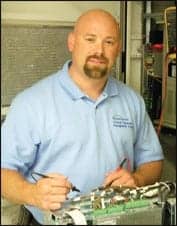After 34 years, the Seminar on Biomedical Instrumentation held its last session in Spring 2005.
 During the late 1960s and early 1970s, concern about the electric hazards of medical instruments increased significantly. Publications ranging from newspapers to professional journals offered articles on the topic. Their authors argued that several thousand patients were being electrocuted annually. The situation suggested the need for a special workshop or seminar for health care staff—not just to explain electric safety, but also to describe the proper use and maintenance of medical instruments.
During the late 1960s and early 1970s, concern about the electric hazards of medical instruments increased significantly. Publications ranging from newspapers to professional journals offered articles on the topic. Their authors argued that several thousand patients were being electrocuted annually. The situation suggested the need for a special workshop or seminar for health care staff—not just to explain electric safety, but also to describe the proper use and maintenance of medical instruments.
The proposal for such a course went to the Illinois Medical Society on March 17, 1970. That society recognized the need and recommended offering the proposal to the Bistate (Missouri and Illinois) Medical Society. That society quickly urged that the course be offered on a national, rather than just a regional, basis.
Location was the next consideration: Which city, which university, which building, and which room? St Louis, which has an almost central location, was an easy choice. The University of Missouri had just opened a campus on the former grounds of the Normandy Country Club, which was located close to the St Louis airport. That campus would soon have an entire building, the JC Penney Building, dedicated to continuing education. Room 222 of that building would accommodate the seminar nicely, according to the architectural plans. Two of the university’s academic departments approved the course and the professors; the next step was to schedule it.
Starting Up
The first session of the course took place at the University of Missouri, St Louis, July 24–28, 1972. On the second day, participants in that session asked that the 9 hours of laboratory time be eliminated to allow more time for lectures. The next curriculum change came in 1978, after participants asked that the 2-hour period during which vendors demonstrated new test equipment be eliminated in favor of more lectures. Subsequent changes involved the “tracking of technology.”
When the educational psychologists who had warned that the course was too intensive heard that the participants wanted even more intensity, they were amazed. The extraordinary motivation of the participants—biomedical equipment technicians (BMETs) and clinical engineers (CEs)—to learn more about medical instrumentation was clear—and certainly commendable. Their motivation was impressive throughout the entire course of the seminar.
The three main topics in the course were physiology, electronics, and medical instrumentation. Thirty-minute breaks separated the 90-minute lecture periods, at least in theory. Breaks were sometimes shorter to allow more time for questions after a lecture.
Growing Pains
By 1975, the demand for the course was such that two sessions each year became necessary. In 1976, a third session each year became necessary, and the location chosen for it was Orange, Calif. Meanwhile, the content of the course was changing because technology was changing. Books could hardly keep up with the pace of technology, so supplementary booklets and handouts supplied the state-of-the-art information. Bigger and stronger briefcases were necessary to accommodate all the materials, which by 1999 included five books, three booklets, and a folder of handouts.
Obtaining all the materials was not always easy. One publisher repeatedly sent books in unacceptable condition. Sometimes, more than half a shipment from that publisher had flaws such as scratched covers, missing pages, and blank pages. A different publisher sent The History of England instead of The Outline of Human Physiology. A binding company ruined most of the booklets by setting the binding heat too high. A travel-products company sent briefcases of the wrong size and the wrong style. Correcting those problems, and others, was especially stressful when unacceptable products arrived just a week or so before the start of a session.
The seminar faced many other challenges: two earthquakes, one major flood, one water-line break under the classroom floor, two hotel fires on the day before a session, and one United Parcel Service strike. At a university in California, all the materials sent 2 weeks ahead of time disappeared from the storage room. The authorities found them, fortunately, in a closet in a dormitory. That discovery was on the Sunday afternoon before the Monday-morning start of the session.
The energizing constant throughout the 34 years was the motivation and response of the participants. Course evaluations remained very high. People were registering months, sometimes more than a year, ahead. Such evidence of appreciation caused the seminar to continue far beyond the original plan for a session or two.
Never a Dull Moment
For the professors, the fun of the seminar began with the start of each session. The other participants, also known as “the students on the other side of the front desk,” brought new questions and considerations. Dull moments did not happen in that kind of environment. Participants came from many kinds of health care facilities, such as hospitals, clinics, and institutes; and from several kinds of educational institutions, such as colleges, technical schools, and universities. They came from all states of the United States; several provinces of Canada; and from overseas: Japan, Germany, England, Turkey, Saudi Arabia, East Caroline Islands, Haiti, and Puerto Rico.
The seminar was decidedly academic, presented only in cooperation with certain universities or with the School of Clinical Engineering of the US Department of Defense. The “home site” was the University of Missouri at St Louis, but seminars were also presented at the University of California, Los Angeles; the University of California, Irvine; Southern Illinois University, Carbondale; Santa Clara University, Santa Clara, Calif; and California’s Orange County campuses of the University of San Francisco and Loyola Marymount University.
Closing the Doors
The expense of moving the course to and from California increased so much that the session in August 2000 was the last one held there. The related plan was to discontinue the Missouri sessions in 2001—to end the seminar where it began in 1972. Waiting lists for sessions in 2001 became so long, however, that plans for retiring the seminar crumbled. They kept crumbling through 2002, 2003, and 2004. One third of a century had slipped by since the course’s very first session took place. The brochure cover for the fall 2004 session carried this phrase: “Announcing the final session of the Seminar in Biomedical Instrumentation.”
When the waiting list for that session increased beyond 20, planning began for a follow-up, or encore, to be held in the spring of 2005. The major difference in preparing for the encore was that no new brochures were printed and mailed. Despite that lack of “advertising,” registration came very close to the maximum of 48. A waiting list did not develop after all: The encore session had room for all who registered.
The Seminar in Biomedical Instrumentation thus completed 34 years of service, quietly and gracefully. Both principal professors thoroughly enjoyed the experience. They are very grateful for the distinct privilege of having helped BMETs and CEs, who—whether directly or indirectly—help so many patients. 24×7
Charles A.. Rawlings, PhD, is professor emeritus, electrical and computer engineering, Southern Illinois University, Carbondale.



